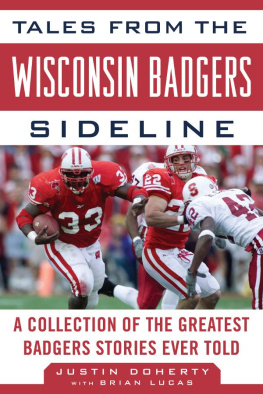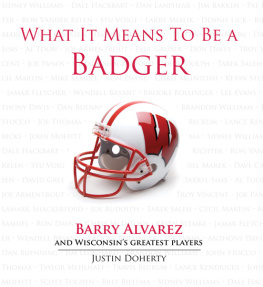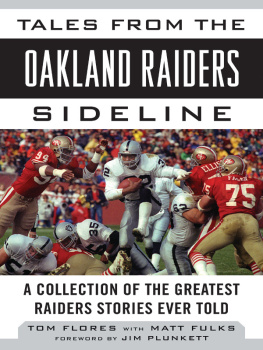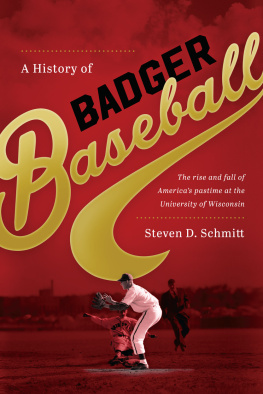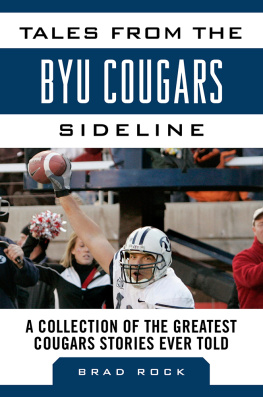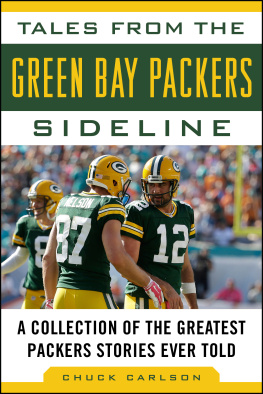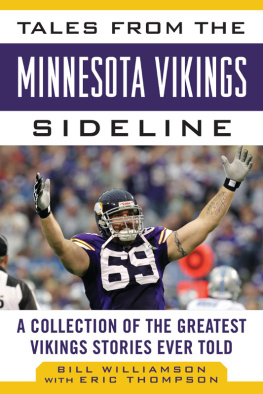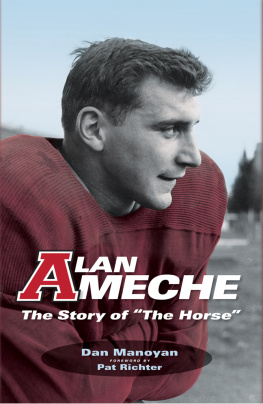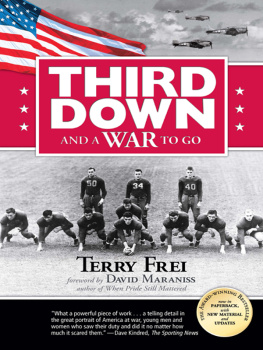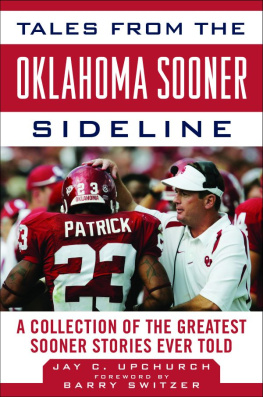
TALES FROM THE
WISCONSIN BADGERS
SIDELINE
A COLLECTION OF THE GREATEST
BADGERS STORIES EVER TOLD
BY
JUSTIN DOHERTY
WITH
BRIAN LUCAS

Copyright 2012 by Justin Doherty and Brian Lucas
All Rights Reserved. No part of this book may be reproduced in any manner without the express written consent of the publisher, except in the case of brief excerpts in critical reviews or articles. All inquiries should be addressed to Sports Publishing, 307 West 36th Street, 11th Floor, New York, NY 10018.
Sports Publishing books may be purchased in bulk at special discounts for sales promotion, corporate gifts, fund-raising, or educational purposes.
Special editions can also be created to specifications. For details, contact the Special Sales Department, Sports Publishing, 307 West 36th Street, 11th Floor, New York, NY 10018 or .
Sports Publishing is a registered trademark of Skyhorse Publishing, Inc., a Delaware corporation.
Visit our website at www.sportspubbooks.com
10 9 8 7 6 5 4 3 2 1
Library of Congress Cataloging-in-Publication Data is available on file.
ISBN: 978-1-61321-092-5
Printed in the United States of America
For my family, friends and Badger fans everywhere
CONTENTS
ACKNOWLEDGMENTS
I did the writing, but this book would not have been possible without the assistance, encouragement and support of a great many people.
Thanks, first, to my wife, Martha, and our daughter, Erin. Their unfailing support during the many hours this project required was very meaningful and much appreciated.
To UW associate athletic director Steve Malchow, a friend and professional colleague (actually, my boss) for 11 years, for allowing me to take on this project and for his willingness to edit and offer advice.
To Matt Lepay, the Voice of the Badgers; Mike Lucas, longtime Madison columnist and color commentator for Badger sports; Dennis Chaptman of University Communications; Allison Wachs, a former student associate in our office who is now a researcher at ESPN; and associate athletic director John Chadimathanks so much for taking the time to read, edit, and make suggestions.
The following individuals graciously allowed me the time to interview them in my effort to uncover some untold stories or to simply relive some really good ones. I appreciate the time each of these people gave to me: Barry Alvarez, Doug Beard, Brooks Bollinger, Wendell Bryant, Father Mike Burke, Tom Butler, John Chadima, John Dettmann, Lee Evans, Jeff Horton, Jim Hueber, Kevin Kluender, Mike Leckrone, Matt Lepay, Mike Lucas, Mike Mahnke, Steve Malchow, Bill Marek, Jeff Nelson, Scott Nelson, Pat OConnor, John Palermo, Joe Panos, Mark Peeler, Jamie Pollard, Pat Richter, Will Roleson, Joe Rudolph, Jim Sorgi, Brian White, and Bernie Wyatt.
Greg Bonds fascinating research on Wisconsins African-American athletic history, which is available at www.uwbadgers.com, was very helpful.
I am grateful to David Stluka for the use of his excellent photography, not only on the cover of the original edition, but also on the inside pages of this book.
Thanks to Mike Pearson of Sports Publishing LLC, for encouraging me to get involved with this book, and to my editor, Gina Sabbia, a Wisconsin graduate who helped guide me through the process.
Finally, thanks to my parents, who always encouraged and supported my interests. My father passed away while I was writing this book, but I hope he would have liked the final product.
FOREWORD
I t doesnt seem possible that almost 16 years have passed since I came to Madison as head football coach at Wisconsin. I can still clearly remember my first meeting with Pat Richter, holding my first press conference to announce that I had accepted the position and then heading out immediately to start recruiting.
In fact, we signed many players that winter who helped form the nucleus of our first Big Ten and Rose Bowl championship team in 1993. Those players, and the hundreds who came after them, represent some of my most special memories. It is the relationships you form with the young men, as well as fellow coaches, staff members and fans, that make my job so rewarding.
In addition to trying to help our players mature, receive an education, and become productive parts of our society, however, we are also trying to win football games. The big games we have won, the great performances of our players, our fantastic fans at Camp Randall Stadiumthose things will stick with me forever.
There are so many great memories. Our win over Ohio State in 1992 was our first over a nationally ranked opponent. The trip to Tokyo, clinching the 1993 Big Ten title and winning the Rose Bowl. The win at sixth-ranked Penn State that stopped the Nittany Lions 20-game winning streak in 1995. The Ron Dayne Game against Iowa in 1999 and our back-to-back conference and Rose Bowl crowns in 1998 and 1999. Lee Evanss 79-yard touchdown reception against No. 3 Ohio State at Camp Randall in 2003. These are just a few of the highlights that come to my mind.
It is not just about the games, either. As I mentioned earlier, its the relationships. It makes me so proud to see our former players doing well in their chosen fields of work and in their personal lives. I enjoy them returning to Camp Randall, even if it is just for a few minutes to say hello.
But Badger football is also about a long history of players, games, coaches and fans that were here long before I ever got to Madison. The stories of Pat ODea, Elroy Crazylegs Hirsch, Pat Richter, Rufus Ferguson, Billy Marek and Al Toon. Memorable games like the 1942 win over No. 1-ranked Ohio State, the 1963 Rose Bowl, the 1981 season-opening victory over Michigan. Its all part of Badger football.
I know youll enjoy reading about just some the players, coaches, staff and games that form what is a rich and colorful football tradition at Wisconsin.
GO BADGERS!
Barry Alvarez,
Director of Athletics, former Head Football Coach
CHAPTER ONE
1889-1919
W isconsin actually started playing football in 1889, but several significant things happened for the program as it proceeded through the 1890s. First off, Wisconsin won quite a bit. The UW was 56-18-3 during its first full decade of play, including being the winner of the first two Big Ten (then Western) Conference titles under the direction of head coach Phil King.
Speaking of the Western Conference, in 1896 Wisconsin joined Chicago, Illinois, Michigan, Minnesota, Northwestern, and Purdue as charter members of what later became the Big Ten.
Wisconsins famed fight song, On Wisconsin, was introduced in 1909 and later during this period Wisconsin had its first All-American (Robert Butts Butler) named. Others like Howard Cub Buck and Arlie Mucks Sr. starred for the Badgers, and in 1917 Camp Randall Stadium opened.
Why They Call It Camp Randall
Few college football facilities in the United States are as unique and steeped in history as Wisconsins Camp Randall Stadium.
Prior to the Civil War, the State Agricultural Society owned the site and used it for state fairs. When the war began, however, the grounds were turned over to the government to be used as a military training center. Some 70,000 soldiers trained at the camp, which also featured a hospital and a prison for Confederate soldiers on its grounds.
The state fair returned following the war (General U.S. Grant referred to the transformation as a symbol of beating the spears of war into the plowshares of peace), but eventually moved to Milwaukee. Rather than put the land up for sale, the state, at the urging of Civil War veterans, gave the land to the University in 1893. Veterans favored naming it Camp Randall instead of Randall Field in honor of the sites function during the Civil War (it was originally named for Alexander Randall, the states first wartime governor).
Next page
